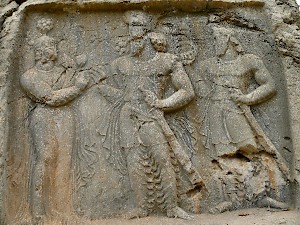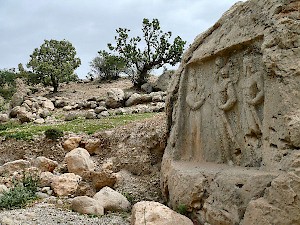Sarab-e Qandil
Q3473296Sarab-i Qandil ("ice cold spring"): town in Fars, Iran, near modern Kazerun, site of a Sasanian rock relief.

The Iranian king Bahrām II (r.276-293) was not the strongest ruler of the Sasanian dynasty. Having lost a war against the Roman emperor Carus, he accepted the loss of Armenia and Mesopotamia; he had some difficulty in suppressing a revolt by his brother Hormizd; and in the end, he lost power to the Zoroastrian high priest Kartir. Still, Bahram managed to introduce new standards of relief art. He introduced new kind of scenes: images of intimacy like this one, enthroned frontal representations (Sarab-e Bahram), or fights against lions (Sar Mashhad). He also used new sites, which had never been used before. Bahrām II left no less than ten rock reliefs.
One of these can be seen at Sarab-e Qandil (near modern Kazerun), shows the queen offering a lotus flower to her husband. The two characters look at each other, while a prince (probably their son, the future king Bahram III) holds the ring of power (called farshiang or cydaris), which is, surprisingly, not ribboned. Such representations of love are very rare in Sasanian iconography, which generally consists of audience, victory, or inauguration scenes. An equivalent image of love was carved at Barm-e Dilak, where it is the king who offers the flower to the queen.
Like almost Iranian rock reliefs, this one is located near a source of water. The relief is contained in a quadrangular frame, carved on a isolated rock beside the bed of a river, without having been much eroded or damaged by the water. Its isolation from frequented roads might explain its excellent state of conservation: it was not accessible for vandals.

The carving is well-executed. Special attention has been paid to the clothes, which show beautiful and fine details, giving an impression of lightness, of aerial movement. The king appears to wear his winged crown and jewels. His left hand is on the top of his sword. His right hand is open, waiting for the gift. The composition shows the royal figure at the center of the panel, the queen being on his right, the prince being on his left/back. Both attitudes of the king and the queen express love and respect.
Although this relief is generally attributed to Bahram II, the lack of an inscription makes that we're not completely certain. The main arguments for an identification with Bahram II lay in the fact that he is the only Sasanian king who showed his queen on coins, and that the female figure might appear to be dressed more like a queen and not a goddess. Scholars like Vanden Berghe and Aerinck, therefore, think that the relief can be attributed to Bahram II. However, Lewitt-Tawill maintains that the relief represents Ardašir I and the goddess, the prince being Shapur I.
Literature
- Louis Vanden Berghe, Reliefs rupestres de l' Iran ancien (1983 Brussels) 76-80
- D. Levit-Tawil, "Re-dating the Sasanian reliefs at Tang-e Qandil and Barm-e Dilak: composition and style as dating criteria," in: Iranica Antiqua 28, 1993, pp. 141-168.